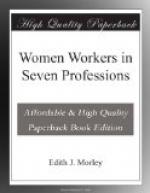The training includes theoretical as well as practical work, and the idea which used to be prevalent, is now practically exploded, that a girl who could not pass examinations but who was fairly good at gymnastics or games might make a good gymnastic teacher. The theoretical subjects include Physiology, Hygiene, Anatomy, Theory of Movements, Psychology, and a certain amount of Pathology; whilst the practical side includes Educational Gymnastics and Teaching, Remedial Gymnastics and Massage, Games (hockey, cricket, lacrosse, lawn tennis, net-ball, and gymnasium games), Swimming and Dancing. Dancing is becoming more and more, a necessary part of the equipment for the successful gymnastic teacher, who must be able to teach the ordinary ball-room dances as well as Morris and country dances.
A typical week’s work in the second year’s course in one of the colleges includes six hours’ Gymnastics; five hours’ Remedial Gymnastics, and five hours’ actual treatment under supervision, of patients in the clinic; six hours’ Anatomy, two hours’ Physiology, two hours’ Hygiene, two hours’ Vaulting, three and a half hours’ Dancing. In addition to this, four afternoons (from 2 to 4 P.M.) are devoted to games; class singing-lessons are given twice a week for half an hour, in addition to a quarter of an hour’s practice every day, and each student teaches in the elementary schools three half hours a week, and also gets some practice in the high school. Add to all this the time required for private study, and it will be seen that the work is fairly strenuous and that none but strong, healthy girls should undertake it.
After the course of training the gymnastic teacher usually takes a post in a school, and having had a few years’ experience, may then become an organiser or inspector to an education committee, a trainer in an elementary training college or physical training college, the head of the gymnastic department of a school clinic, or she may prefer to start a private practice, holding classes, treating cases of deformity, and also acting as visiting gymnastic teacher or games-coach to schools in the neighbourhood.
The rate of remuneration varies according to the kind of work undertaken; the initial salary in schools is usually L60 to L80 per annum resident, or L100 to L120 non-resident. Organisers and inspectors command a much higher salary; the three Government inspectors start at L200 rising to L400 with first-class travelling expenses, and the four woman-organisers employed by the London County Council Education Committee start at L175, rising by L10 a year to L240 plus actual travelling expenses. Some women do well in private practice, making from L200 to L300 a year. The salaries of the gymnastic teachers in the London County Council secondary schools are fixed at L130 a year with no possibility of advancement, and, though this may compare favourably with the initial salaries of other teachers on the staff, it must be remembered




